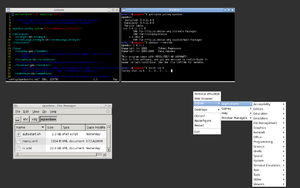Openbox
|
Basic Openbox X-Session | |
| Developer(s) | Dana Jansens,[1][2] Mikael Magnusson[3] |
|---|---|
| Initial release | 18 September 2002 |
| Stable release |
3.6.1[4]
/ 1 July 2015 |
| Repository |
github |
| Written in | C |
| Operating system | Unix-like |
| Type | Stacking window manager |
| License | GPLv2+[5] |
| Website |
openbox |

Openbox is a free, stacking window manager for the X Window System, licensed under the GNU General Public License.[5] Originally derived from Blackbox[5] 0.65.0 (a C++ project), Openbox has now been totally re-written in the C programming language and since version 3.0 is no longer based upon any code from Blackbox.[6]
Openbox is designed to be small, fast, and fully compliant with the Inter-Client Communication Conventions Manual (ICCCM) and Extended Window Manager Hints (EWMH).[7] It supports many features such as menus by which the user can control applications or which display various dynamic information.[5]
Openbox is the standard window manager in LXDE, and is used in Linux distributions such as CrunchBang Linux, ArchBang, Lubuntu, TinyMe and Trisquel Mini.[8][9][10][11][12][13][14]
The primary author of Openbox is Dana Jansens of Carleton University in Ottawa, Ontario, Canada.[1][15]
Using Openbox
Openbox allows a right-click (or any other key-binding) "root menu" on the desktop,[5] and allows users to configure the way windows are managed. When a window is minimized, it becomes invisible. To bring windows up again, most use Alt+Tab ↹ or the Desktop menu, accessible by right-clicking. Extending Openbox with other small programs that add icons, taskbars,[5] launchers, eyecandy and others is common.
Configuration

There are only two configuration files, both located in ~/.config/openbox. They are named menu.xml and rc.xml. These can either be edited manually or with ObConf and obmenu, both graphical configuration tools.[5][16][17]
All mouse and key-bindings can be configured. For example, a user can set:
- a window to go to desktop 3 when the close button is clicked with the middle mouse button
- when scrolling on an icon to move to the next/previous desktop
- raise or not raise when clicking/moving a window
Pipe menus
Openbox has a dynamic menu system called "pipe menus".[5][18] It accepts the output of a script and use it as the source for a menu. Each time the user points their mouse at the sub-menu, the script is rerun and the menu is regenerated. This allows users and software developers more flexibility than the static menus found in other window managers.
See also
References
- 1 2 Jansens, Dana (November 2007). "User:DanaJansens". Retrieved 19 January 2015.
- ↑ Jansens, Dana. "Openbox Developer Dana Jansens". Retrieved 19 January 2015.
- ↑ "git.openbox.org Git - dana/openbox.git/summary". openbox.org. Retrieved 25 August 2015.
- ↑ http://openbox.org/wiki/Openbox:Changelog
- 1 2 3 4 5 6 7 8
- Saunders, Mike (March 2008). "Lightweight window managers". Linux Format. UK: Future Publishing (103).* Сондерс, Майк (March 2008). Легковесные ОМ (PDF). Linux Format (in Russian). Russia: Mezon.ru (103): 21.
- ↑ GentooWiki (March 2008). "HOWTO Openbox". Archived from the original on 2008-04-03. Retrieved 2008-04-07.
- ↑ "EWMH Compliance Document". Retrieved 2009-09-09.
- ↑ LXDEWiki (September 2008). "LXDE Wiki". Retrieved 2008-09-28.
- ↑ CrunchBang Linux (December 2008). "CrunchBang Linux". Retrieved 2008-12-29.
- ↑ "Rolling-release (Linux Wiki)". Retrieved 2014-05-29.
- ↑ Lavergne, Julian (October 2010). "Lubuntu Applications". Retrieved 14 January 2011.
- ↑ DistroWatch (August 2010). "Tiny Me". Retrieved 14 January 2011.
- ↑ "Trisquel Mini GNU/Linux". The Trisquel Project. Retrieved 7 November 2012.
- ↑ "Openbox window manager grows up". linux.com. Retrieved 30 October 2016.
- ↑ "Dana Jansens – Medium". medium.com. Retrieved 30 October 2016.
- ↑ Openbox project (June 2007). "ObConf:About". Retrieved 2008-04-07.
- ↑ obmenu:Index, retrieved 2012-03-28
- ↑ "Openbox Wiki:Pipe menus".
External links
| Wikimedia Commons has media related to Openbox. |
